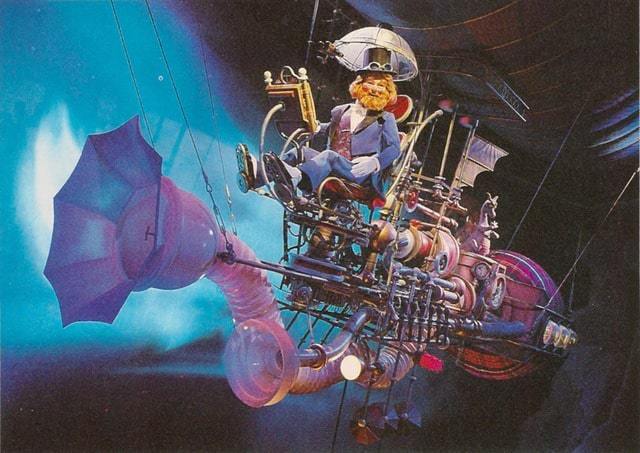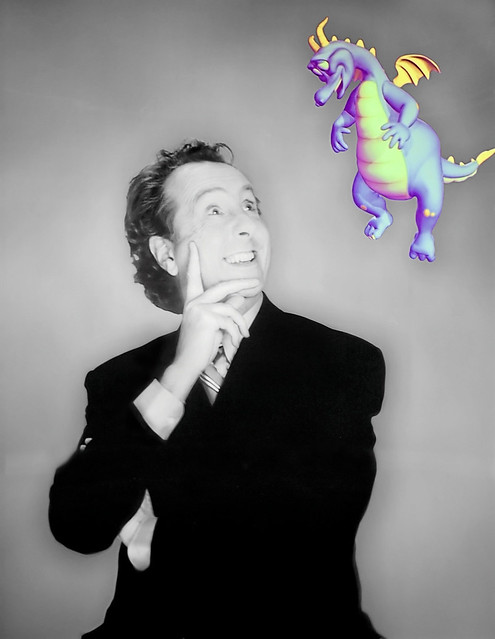“One
little spark, of inspiration, is at the heart, of all creation. Right at the
start, of everything’s that new, one little spark, lights up for you…”
Well, join us for another history lesson, as we delve into the past, the
golden age of Epcot, and explore the evolution (or de-evolution) of one of
Disney’s most sorely missed attractions.
Before existing as a theme park, Epcot was Walt Disney’s last dream – an
independent city of the future to be built as the centrepiece of Walt Disney
World, known as EPCOT (Experimental Prototype Community of Tomorrow). Sadly,
Walt passed away in 1966, and EPCOT was shelved and treated like an
afterthought whilst the Magic Kingdom was built. The company believed they could
not build a city without Walt’s guidance, abandoning the idea, going on to
cover themselves in cobwebs and adopt a mantra of “what would Walt do?” as an
excuse to not try new ideas.
Though the Imagination Pavilion may have looked a little out of place,
despite its beautiful design, it was an essential part to the park’s themes.
Without imagination, mankind’s advances would have been non-existent.
Anyway, the pavilion’s attractions did not open with the rest of the park
in 1982, but followed shortly after. Journey Into Imagination took guests on a
journey through the endless realm of creation and imagination. Guiding us on
the journey was the Dreamfinder, a whimsical, jolly adventurer who was a mix of
Willy Wonka and Santa Claus, and his charming sidekick Figment, a purple dragon
made from his own mind.
The attraction was designed by Tony Baxter, the face of Disney’s second
generation of Imagineers. Working as an ice cream vendor in 1965, Baxter joined
Imagineering several years later, and would go on to create many of the theme
parks’ most popular attractions like Big Thunder Mountain, Indiana Jones
Adventures, Splash Mountain, reimagined Fantasyland in the 1980s, and was the
leader of designing Disneyland Paris. One of his creations that sadly never saw
the light of day was Discovery Bay, a steampunk-esque location which was to
have been built where Star Wars: Galaxy’s Edge will open next year in
Disneyland. Elements from Discovery Bay would be incorporated around the
international themes parks, including in Journey Into Imagination.
The ride’s sponsor was Kodak, who sponsored the many photography shops at
the theme parks. They promised to sponsor whatever the ride would be, as long
as it was “very imaginative”. This was brought to life in the Imagination
Pavilion, with the Dreamfinder and Figment journeying through the imaginary
realms of art, literature, the performing arts, and sciences. The ride was
hugely popular, as were the ride’s characters, and the theme song “One Little
Spark”, written by Richard and Robert Sherman.
For whatever reason, Disney decided to keep their vast catalogue of
iconic characters OUT of Epcot. But, that is where the Dreamfinder and
Figment’s popularity soared. While Chuck McCann voiced Dreamfinder in the ride,
the character (with Figment) appeared as a meet and greet around Epcot, played
by Ron Schneider. They were the unofficial mascots of Epcot, at least until
company CEO Michael Eisner pushed Mickey and co. into the park.
The Imagination Pavilion also had the ImageWorks, used for Kodak to show
off their products, and acting as a fun, interactive assortment of games to
boost the imagination. The signature part of the ImageWorks was the “rainbow
corridor”.
Still, Journey Into Imagination was not without technical problems, being
a difficult ride to maintain and it often shut down. And, Epcot was started to
look a little dated. Though pitched as a sign of the 21st century,
the actual 21st century was approaching fast, and the technology and
future promised in Horizons was not looking likely. And it still isn’t. I want
my jetpack, damnit! And see man land on Mars in my lifetime!
Epcot was meant to get a major overhaul to incorporate some new thrill
rides and freshen the place up a bit. This upgrade never saw the light of day,
as Disneyland Paris was a financial disappointment, and Eisner decided to
kneecap Imagineering in favour of cost-cutting and building pathetic, lifeless,
soulless theme parks by committee. Epcot also needed sponsors to keep its
pavilions up to date. It needed to redefine their theme park by whatever means
necessary and to keep guests interested in visiting it.
Disney characters were brought in to draw the children and families, and
thrill rides began to be introduced, at the sacrifice of beloved favourites,
and Epcot’s core themes. World of Motion was replaced with Test Track, so at
least the transportation theme remained. Horizons was removed in exchange for
Mission Space with the removal of General Electric as a sponsor. The Universe
of Energy saw the inclusion of Ellen DeGeneres and Bill Nye the Science Guy.
The Living Seas gained a Finding Nemo
refurbishment, and The Land gained a rather on the nose Lion King environmental movie. And the Wonders of Life slowly died,
and now is a gutted empty husk occasionally opened to celebrate Epcot’s annual
cultural festivals.
And Journey Into Imagination…
Journey Into Imagination became an attraction that was ironically
unimaginative. Poor Kodak was in the can, financially struggling as, like many
other companies, refused to get with the times and embrace digital photography.
With a limited budget from both Kodak and the lackluster, unimaginative, pencil
pushing nitwits in charge of Disney, Journey Into Imagination’s second
incarnation didn’t have much to work with. In fact, they transformed it into a
spin-off of a spin-off of the film Honey,
I Shrunk the Kids. Long story short, Honey
had a 4D theatre film where the audience was “shrunk”, with Eric Idle guest
starring as Dr. Channing of the Imagination Institute. This institute became
the new basis for Journey’s plot.
Journey Into Imagination was renamed as Journey Into YOUR Imagination,
opening in 1998. Because it apparently needed the guests’ imagination to fill
in the empty layout of the new ride. Gone was Dreamfinder, Figment was reduced
to a cameo, and the once charming nature of the ride was lost, reimagined as a
patronising, insulting ride where the imagination of the guests was fickle and
empty. Eric Idle appeared as Dr. Channing, running the institute, and invited
guests to explore how the five senses could act as an ignition for their
imaginations. The attraction’s size was literally cut in half to save on money.
Even the ImageWorks was gone, replaced with the “What If Labs”, a less
impressive or pricey environment of interactive games.
Needless to say, this new version of the attraction was universally
despised. Even Michael Eisner hated it. Fans hated what had been done to the
attraction, removing its very heart, music, and well, imagination. What was
left was a cheap, unimaginative six-minute ride that insulted the guests rather
than inspire them. Journey Into YOUR Imagination has fallen into the dumpster
bin alongside other hated Disney attractions like Superstar Limo and Stitch’s
Great Escape.
Journey Into YOUR Imagination closed down barely a year and a half after it closed to undergo another regeneration, with the intent to make it closer to the original version. However, the events of 9/11 and another budget cut left the Imagineers with limited money to spend. Journey reopened again as Journey Into Your Imagination With Figment. Yes, everyone’s favourite purple dragon had returned, as had “One Little Spark”. The ride’s story was slightly repurposed, with Dr. Channing and the Imagination Institute still remaining. Much of YOUR Imagination’s layout remained, now just retrofitted to include Figment as he hijacked Channing’s orderly tour of the labs to invoke the spontaneity of imagination. The Dreamfinder got a nod, and even the finale was improved, using all the old Figment animatronics. Heck, even Eric Idle in a Monty Python-esque role is good.
Though it could be considered an improvement from the second version of
the ride, the revised Journey still remained unpopular. Sure, Figment was back,
but gone was his childhood innocence and he was more of a Scrappy Doo/Dennis
the Menace caricature who caused trouble, came off as being rather obnoxious,
and wouldn’t shut up about imagination, despite the ride’s lack of it. There’s
one gag where Figment uses a skunk’s tail to effectively fart at the guests.
How wondrous.
In 2010, Kodak’s sponsorship ended, and it was feared that Journey Into
Imagination would go the way of the dinosaurs…or Ellen’s Energy Adventure in
this case. And Horizons. And the Wonders of Life. Left to fall apart, decay,
and then be replaced with less stellar thrill rides. Still, in 2018, it is
still here. For better or for worse, Journey Into Imagination is still around,
regardless of its current incarnation.
Figment is still hugely popular in Epcot, appearing on tons of
merchandise, even had a cameo in Inside
Out, and his animatronics have been put on display in many Disney
exhibitions. A Destination D23, audiences were blown away when Ron Schneider
reprised his role as Dreamfinder, and took to the stage with Figment and
Richard Sherman, receiving a standing ovation from the crowd.
So, what does the future hold for Journey Into Imagination? Epcot will be
undergoing some major upgrades. The Guardians of the Galaxy are moving into the
Universe of Energy (hopefully with a similar theme), whilst Ratatouille is being brought over from
Disneyland Paris to the French pavilion in Epcot’s World Showcase. For a long
time now, Journey has been rumoured to be replaced by an Inside Out dark ride. While this doesn’t sound like a bad idea, I
personally feel that such a ride would exist better within the disused Wonders
of Life Pavilion. If I had my way, Journey would be restored/updated to a new
ride similar to the original, with Dreamfinder and Figment back where they
belong.
I can imagine that, can’t I?




